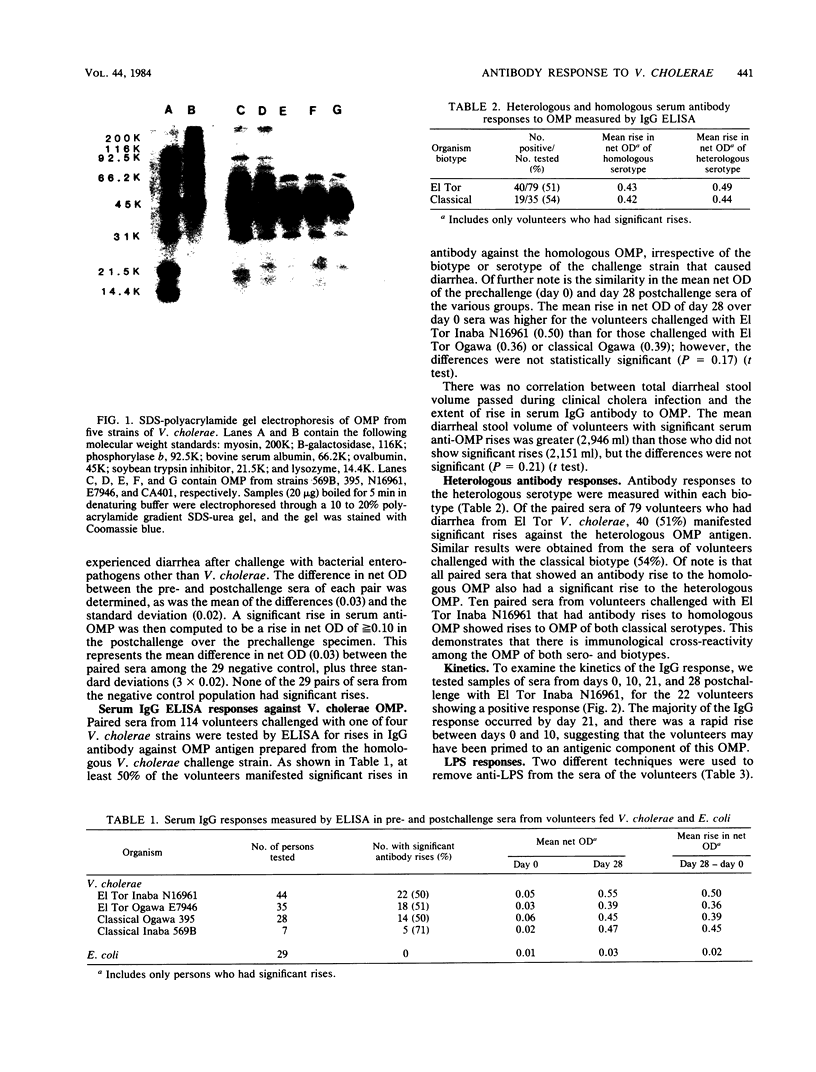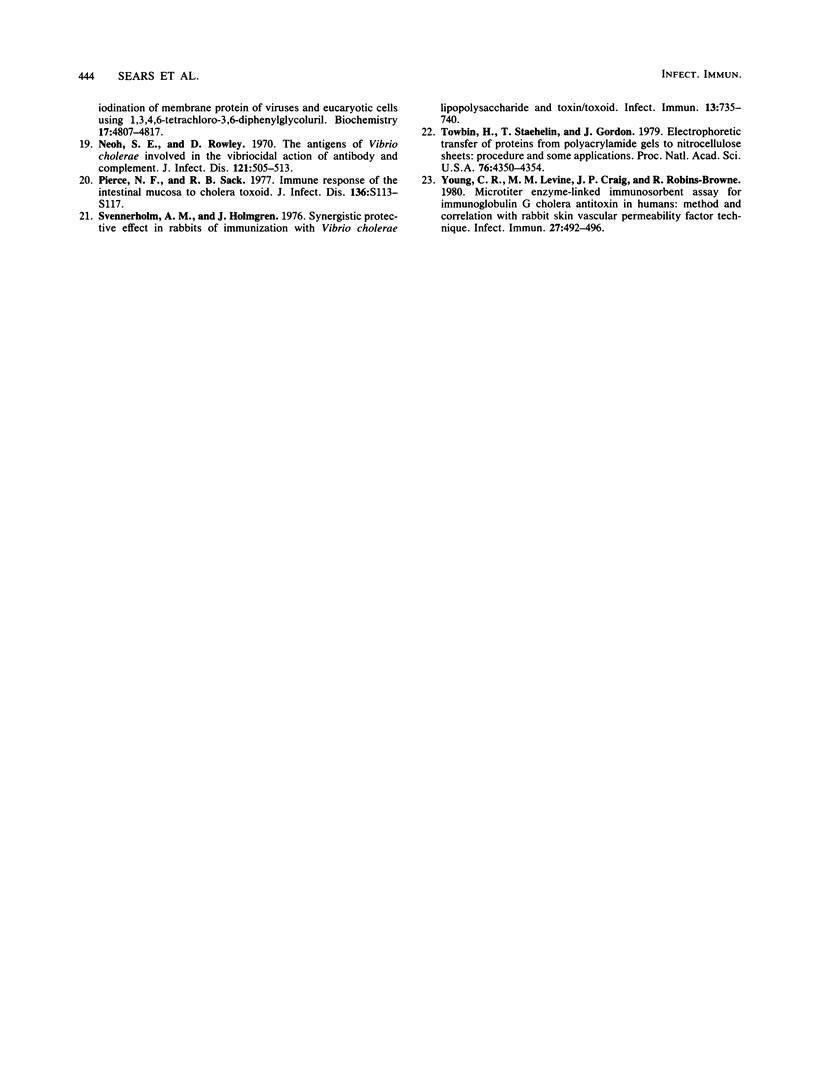Abstract
The immune response of 114 volunteers with diarrhea after experimental challenge with four strains of Vibrio cholerae O1 was characterized in a microtiter enzyme-linked immunosorbent assay antibody detection system by using a partially purified outer membrane preparation (OMP) from these strains as an antigen. Analysis of paired sera from 29 persons with noncholera diarrhea (negative control population), demonstrated that a rise in net optical density greater than 0.10 was significant. A total of 50% of the 79 cholera volunteers challenged with El Tor biotype and 54% of the 35 volunteers challenged with classical biotype had significant rises in immunoglobulin G anti-OMP. Paired sera that showed significant rises when tested against homologous OMP all manifested significant rises when also tested against a serotype-heterologous OMP. Immunoblotting techniques showed that the antigens to which antibodies were reacting were mainly protein in nature, not lipopolysaccharide. Furthermore, absorption with lipopolysaccharide decreased the optical density by a mean of only 12% (0 to 30%), corroborating that antibody was mainly directed against OMP and not lipopolysaccharide. This study indicates that there is a human immunoglobulin G response to OMP during clinical cholera infection and that this response is constant among bio- and serotypes.
Full text
PDF





Images in this article
Selected References
These references are in PubMed. This may not be the complete list of references from this article.
- Attridge S. R., Rowley D. Prophylactic significance of the nonlipopolysaccharide antigens of Vibrio cholerae. J Infect Dis. 1983 Nov;148(5):931–939. doi: 10.1093/infdis/148.5.931. [DOI] [PubMed] [Google Scholar]
- Bing D. H., Weyand J. G., Stavitsky A. B. Hemagglutination with aldehyde-fixed erythrocytes for assay of antigens and antibodies. Proc Soc Exp Biol Med. 1967 Apr;124(4):1166–1170. doi: 10.3181/00379727-124-31953. [DOI] [PubMed] [Google Scholar]
- Cryz S. J., Jr, Fürer E., Germanier R. Development of an enzyme-linked immunosorbent assay for studying Vibrio cholerae cell surface antigens. J Clin Microbiol. 1982 Jul;16(1):41–45. doi: 10.1128/jcm.16.1.41-45.1982. [DOI] [PMC free article] [PubMed] [Google Scholar]
- Eubanks E. R., Guentzel M. N., Berry L. J. Evaluation of surface components of Vibrio cholerae as protective immunogens. Infect Immun. 1977 Feb;15(2):533–538. doi: 10.1128/iai.15.2.533-538.1977. [DOI] [PMC free article] [PubMed] [Google Scholar]
- Finkelstein R. A. Antitoxic immunity in experimental cholera: observations with purified antigens and the ligated ileal loop model. Infect Immun. 1970 May;1(5):464–467. doi: 10.1128/iai.1.5.464-467.1970. [DOI] [PMC free article] [PubMed] [Google Scholar]
- Freter R. Parameters affecting the association of vibrios with the intestinal surface in experimental cholera. Infect Immun. 1972 Aug;6(2):134–141. doi: 10.1128/iai.6.2.134-141.1972. [DOI] [PMC free article] [PubMed] [Google Scholar]
- Glass R. I., Becker S., Huq M. I., Stoll B. J., Khan M. U., Merson M. H., Lee J. V., Black R. E. Endemic cholera in rural Bangladesh, 1966-1980. Am J Epidemiol. 1982 Dec;116(6):959–970. doi: 10.1093/oxfordjournals.aje.a113498. [DOI] [PubMed] [Google Scholar]
- Hawkes R., Niday E., Gordon J. A dot-immunobinding assay for monoclonal and other antibodies. Anal Biochem. 1982 Jan 1;119(1):142–147. doi: 10.1016/0003-2697(82)90677-7. [DOI] [PubMed] [Google Scholar]
- Johnston K. H., Holmes K. K., Gotschlich E. C. The serological classification of Neisseria gonorrhoeae. I. Isolation of the outer membrane complex responsible for serotypic specificity. J Exp Med. 1976 Apr 1;143(4):741–758. doi: 10.1084/jem.143.4.741. [DOI] [PMC free article] [PubMed] [Google Scholar]
- Kabir S. Composition and immunochemical properties of outer membrane proteins of Vibrio cholerae. J Bacteriol. 1980 Oct;144(1):382–389. doi: 10.1128/jb.144.1.382-389.1980. [DOI] [PMC free article] [PubMed] [Google Scholar]
- Kabir S. Immunochemical properties of the major outer membrane protein of Vibrio cholerae. Infect Immun. 1983 Jan;39(1):452–455. doi: 10.1128/iai.39.1.452-455.1983. [DOI] [PMC free article] [PubMed] [Google Scholar]
- Kelley J. T., Parker C. D. Identification and preliminary characterization of Vibrio cholerae outer membrane proteins. J Bacteriol. 1981 Feb;145(2):1018–1024. doi: 10.1128/jb.145.2.1018-1024.1981. [DOI] [PMC free article] [PubMed] [Google Scholar]
- LOWRY O. H., ROSEBROUGH N. J., FARR A. L., RANDALL R. J. Protein measurement with the Folin phenol reagent. J Biol Chem. 1951 Nov;193(1):265–275. [PubMed] [Google Scholar]
- Laemmli U. K. Cleavage of structural proteins during the assembly of the head of bacteriophage T4. Nature. 1970 Aug 15;227(5259):680–685. doi: 10.1038/227680a0. [DOI] [PubMed] [Google Scholar]
- Levine M. M., Black R. E., Clements M. L., Cisneros L., Nalin D. R., Young C. R. Duration of infection-derived immunity to cholera. J Infect Dis. 1981 Jun;143(6):818–820. doi: 10.1093/infdis/143.6.818. [DOI] [PubMed] [Google Scholar]
- Levine M. M., Nalin D. R., Craig J. P., Hoover D., Bergquist E. J., Waterman D., Holley H. P., Hornick R. B., Pierce N. P., Libonati J. P. Immunity of cholera in man: relative role of antibacterial versus antitoxic immunity. Trans R Soc Trop Med Hyg. 1979;73(1):3–9. doi: 10.1016/0035-9203(79)90119-6. [DOI] [PubMed] [Google Scholar]
- Neoh S. H., Rowley D. The antigens of Vibrio cholerae involved in the vibriocidal action of antibody and complement. J Infect Dis. 1970 May;121(5):505–513. doi: 10.1093/infdis/121.5.505. [DOI] [PubMed] [Google Scholar]
- Pierce N. F., Sack R. B. Immune response of the intestinal mucosa to cholera toxoid. J Infect Dis. 1977 Aug;136 (Suppl):S113–S117. doi: 10.1093/infdis/136.supplement.s113. [DOI] [PubMed] [Google Scholar]
- Svennerholm A. M., Holmgren J. Synergistic protective effect in rabbits of immunization with Vibrio cholerae lipopolysaccharide and toxin/toxoid. Infect Immun. 1976 Mar;13(3):735–740. doi: 10.1128/iai.13.3.735-740.1976. [DOI] [PMC free article] [PubMed] [Google Scholar]
- Towbin H., Staehelin T., Gordon J. Electrophoretic transfer of proteins from polyacrylamide gels to nitrocellulose sheets: procedure and some applications. Proc Natl Acad Sci U S A. 1979 Sep;76(9):4350–4354. doi: 10.1073/pnas.76.9.4350. [DOI] [PMC free article] [PubMed] [Google Scholar]
- Young C. R., Levine M. M., Craig J. P., Robins-Browne R. Microtiter enzyme-linked immunosorbent assay for immunoglobulin G cholera antitoxin in humans: method and correlation with rabbit skin vascular permeability factor technique. Infect Immun. 1980 Feb;27(2):492–496. doi: 10.1128/iai.27.2.492-496.1980. [DOI] [PMC free article] [PubMed] [Google Scholar]




